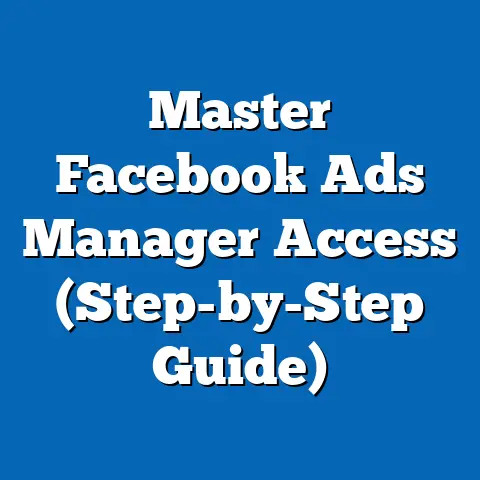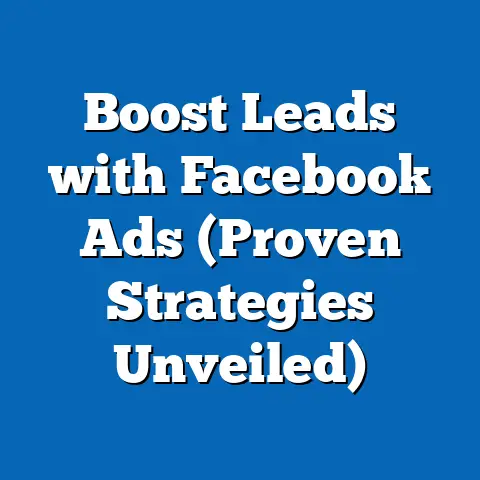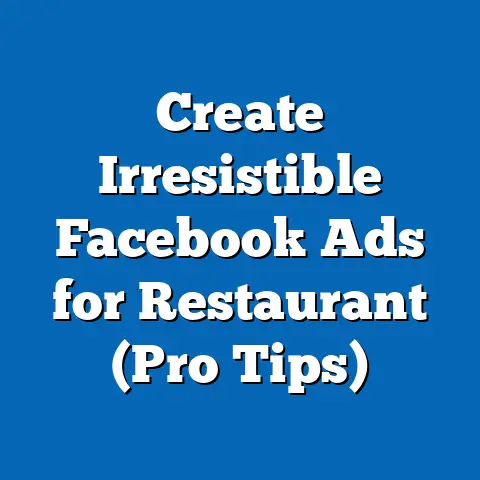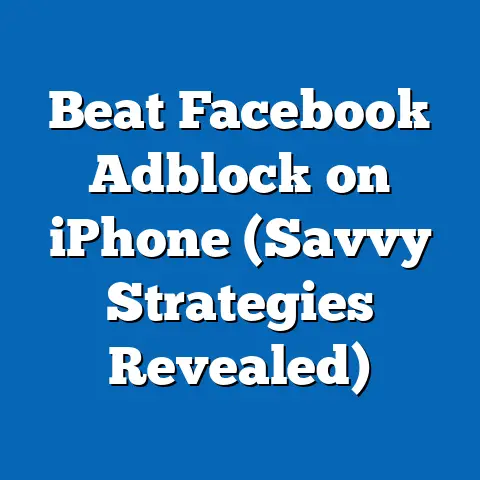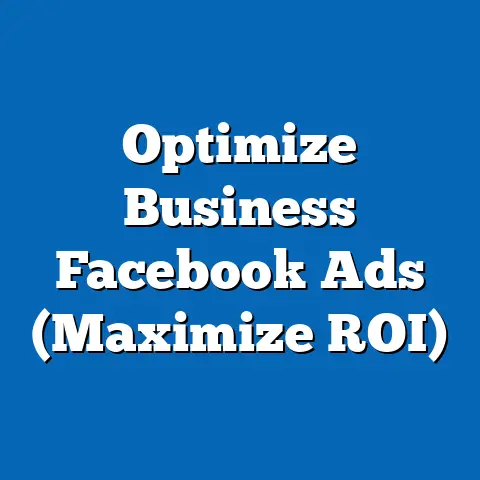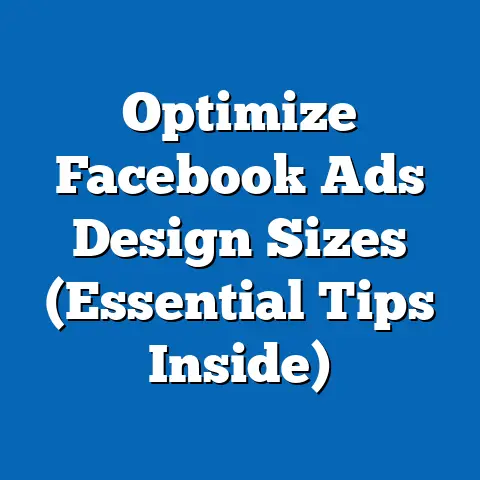Grow Facebook Group (Expert Advertising Strategies)
I’ve always believed in the power of connection. In a world that often feels isolating, finding a community where you belong can be transformative. That’s why I’m so passionate about Facebook Groups. They’re not just another social media feature; they’re digital hearths where like-minded individuals gather, share, and support each other. And when those groups are focused on health and wellness, the impact can be profound.
Imagine a place where you can openly discuss your struggles with anxiety, share your triumphs in overcoming fitness goals, or find recipes that cater to your dietary needs. That’s the potential of a thriving Facebook group dedicated to health and wellness. Studies have consistently shown that strong social connections are vital for mental and physical well-being. Being part of a supportive community can reduce stress, boost your immune system, and even increase longevity. A 2010 meta-analysis published in PLoS Medicine found that strong social relationships were associated with a 50% increased likelihood of survival. That’s a statistic that really hit home for me, highlighting the tangible benefits of connection.
Understanding the Importance of Facebook Groups
In today’s digital landscape, social media platforms are more than just places to share vacation photos and witty updates. They’re evolving into hubs for community building, knowledge sharing, and even business development. Within this ecosystem, Facebook Groups stand out as a particularly powerful tool for fostering connection and engagement.
Think about it: Personal profiles are primarily for connecting with friends and family. Business pages are designed to promote products and services. But Facebook Groups? They’re dedicated spaces for people with shared interests, passions, or goals to come together and interact. This focus on community is what sets them apart.
Why Groups Are Different (and Better in Some Ways):
- Deeper Connections: Unlike the fleeting nature of the newsfeed, groups encourage meaningful conversations and ongoing interactions.
- Shared Identity: Members identify with the group’s purpose, creating a sense of belonging and shared identity.
- Focused Discussions: Groups allow for in-depth discussions on specific topics, without the noise of irrelevant content.
- Direct Access: Group admins and members can directly communicate with each other, fostering a more personal connection.
The trend towards community-driven social media is undeniable. People are craving authentic connections and a sense of belonging in an increasingly digital world. Facebook Groups provide that space. They allow individuals to find their tribe, share their experiences, and learn from others.
Examples of Successful Facebook Groups:
To illustrate the power of Facebook Groups, let’s look at a few examples, particularly those focused on health and wellness:
- Weight Watchers Reimagined: This group provides support and motivation for individuals following the Weight Watchers program. Members share recipes, tips, and encouragement, creating a strong sense of community.
- Keto for Beginners: A group dedicated to helping people start and maintain a ketogenic diet. Members share recipes, answer questions, and provide support.
- Mindfulness Meditation: This group offers a space for individuals to practice mindfulness and meditation. Members share guided meditations, tips for managing stress, and support for their mindfulness journey.
- Chronic Illness Support: A safe space for individuals living with chronic illnesses to share their experiences, ask questions, and find support.
These examples demonstrate the diverse range of topics and communities that can thrive within Facebook Groups. Whether it’s weight loss, mental health, or chronic illness, groups provide a valuable resource for connection, support, and knowledge sharing.
Takeaway: Facebook Groups are more than just a feature; they’re a powerful tool for building communities and fostering meaningful connections. Understanding their unique advantages is the first step in unlocking their potential for growth.
Defining Your Target Audience
Before you even think about creating your Facebook ad, you need to know who you’re trying to reach. This isn’t just about demographics like age and location; it’s about understanding their interests, needs, and pain points. Defining your target audience is crucial for crafting compelling messaging and ensuring your ads reach the right people.
Why is this so important? Imagine you’re selling running shoes. You wouldn’t advertise to people who primarily enjoy indoor activities like reading or knitting, right? The same principle applies to Facebook Groups. You need to target individuals who are genuinely interested in the topic of your group.
Methods for Research and Analysis:
- Facebook Audience Insights: This tool provides valuable data about the demographics, interests, and behaviors of people on Facebook. You can use it to research potential group members and identify their key characteristics.
- Competitor Analysis: Analyze existing Facebook Groups in your niche. Who are their members? What kind of content do they engage with? This can provide valuable insights into your target audience.
- Surveys and Polls: Conduct surveys or polls within existing communities or on your business page to gather information about your target audience’s needs and interests.
- Keyword Research: Use keyword research tools to identify the terms and phrases your target audience is searching for online. This can help you tailor your messaging to their specific interests.
- Talk to People!: Don’t underestimate the power of direct communication. Reach out to potential group members and ask them about their needs, interests, and challenges.
Creating Buyer Personas:
Once you’ve gathered enough data, it’s time to create buyer personas. These are fictional representations of your ideal group members, based on your research and analysis.
Example Buyer Persona:
- Name: Sarah Miller
- Age: 35
- Location: Austin, Texas
- Occupation: Marketing Manager
- Interests: Healthy eating, yoga, running, mindfulness
- Pain Points: Struggles with maintaining a healthy lifestyle due to a busy work schedule. Feels stressed and overwhelmed. Looking for a supportive community to help her stay motivated.
- Goals: To improve her physical and mental well-being, reduce stress, and find a healthy work-life balance.
By creating detailed buyer personas, you can better understand your target audience’s needs, motivations, and challenges. This will help you craft compelling messaging that resonates with them on a personal level.
Crafting Compelling Messaging:
Your messaging should address your target audience’s pain points and highlight the benefits of joining your Facebook Group.
- Focus on the Value Proposition: What will members gain by joining your group? Will they learn new skills? Find support? Connect with like-minded individuals?
- Use Emotional Language: Tap into your target audience’s emotions. Speak to their desires, fears, and aspirations.
- Highlight the Community Aspect: Emphasize the supportive and welcoming nature of your group.
- Use Clear and Concise Language: Avoid jargon and technical terms. Make your messaging easy to understand and relatable.
Takeaway: Defining your target audience is the foundation of any successful Facebook Group growth strategy. By understanding their needs, interests, and pain points, you can craft compelling messaging that resonates with them and motivates them to join your community.
Creating Engaging Content to Attract Members
Content is king, and in the realm of Facebook Groups, it’s the lifeblood that attracts and retains members. But not all content is created equal. To truly engage your audience, you need to create content that is relevant, valuable, and, most importantly, resonates with their interests and needs.
What Types of Content Resonate?
When it comes to health and wellness, certain types of content tend to perform particularly well:
- Educational Content: Articles, infographics, and videos that provide valuable information about health topics, fitness tips, and healthy recipes.
- Inspirational Content: Stories of personal transformation, motivational quotes, and images that inspire and uplift members.
- Interactive Content: Polls, quizzes, and Q&A sessions that encourage members to participate and share their opinions.
- Community-Driven Content: Discussions, challenges, and events that foster a sense of community and belonging.
- Personal Stories: Sharing your own experiences, challenges, and triumphs can build trust and create a deeper connection with your audience.
Content Formats to Stimulate Engagement:
- Live Videos: Host live Q&A sessions with experts, share workout routines, or conduct cooking demonstrations. Live videos are a great way to engage with your audience in real-time.
- Infographics: Visually appealing infographics can present complex information in an easy-to-understand format.
- Polls: Use polls to gather feedback from your audience, spark discussions, and learn more about their preferences.
- Discussions: Start conversations by asking thought-provoking questions, sharing news articles, or discussing relevant topics.
- Challenges: Create challenges related to health and wellness, such as a 30-day fitness challenge or a healthy eating challenge.
Creating a Content Calendar:
Consistency is key when it comes to content creation. A content calendar can help you plan and schedule your content in advance, ensuring a steady stream of engaging posts.
- Identify Key Themes: Identify key themes related to health and wellness that align with your group’s purpose.
- Plan Content Around Events: Align your content with relevant health-related events, such as National Heart Month or Mental Health Awareness Month.
- Batch Create Content: Dedicate specific days to creating content in batches. This can help you stay organized and efficient.
- Schedule Your Posts: Use Facebook’s scheduling tool to schedule your posts in advance. This will help you maintain a consistent posting schedule.
The Importance of Consistency and Authenticity:
In today’s digital world, people are bombarded with information. To stand out from the crowd, you need to be both consistent and authentic.
- Consistency: Post regularly to keep your audience engaged and interested.
- Authenticity: Be genuine and transparent in your communication. Share your own experiences and be open to feedback.
- Build Trust: Earn your audience’s trust by providing valuable information and creating a safe and supportive community.
My Personal Experience:
I remember when I started my own wellness group. I was so focused on posting “perfect” content that I forgot to be myself. The engagement was low, and I felt disconnected from my audience. It wasn’t until I started sharing my own struggles and vulnerabilities that things started to change. People began to connect with me on a personal level, and the community began to thrive.
Takeaway: Creating engaging content is essential for attracting and retaining members in your Facebook Group. By focusing on relevant, valuable, and authentic content, you can build a thriving community that supports and inspires its members.
Leveraging Facebook Ads to Promote Your Group
Creating great content and having a clear target audience is half the battle. The other half? Getting that content in front of the right people. That’s where Facebook Ads come in. They’re a powerful tool for promoting your group and reaching potential members who are genuinely interested in what you have to offer.
Types of Facebook Ads for Group Promotion:
- Image Ads: Simple and effective, image ads use a compelling visual and concise text to capture attention.
- Video Ads: Highly engaging, video ads can showcase your group’s personality, share testimonials, or provide valuable information.
- Carousel Ads: Allow you to display multiple images or videos in a single ad, perfect for showcasing different aspects of your group.
- Collection Ads: Designed for e-commerce, but can be adapted to promote your group by showcasing related products or services.
- Lead Generation Ads: Collect leads directly from Facebook users, allowing you to follow up with potential members.
Creating Targeted Ad Campaigns:
The key to successful Facebook advertising is targeting. You need to ensure your ads are reaching the right people, based on their demographics, interests, and behaviors.
- Use Detailed Targeting Options: Facebook offers a wide range of targeting options, including age, gender, location, interests, behaviors, and demographics.
- Create Custom Audiences: Upload a list of email addresses or phone numbers to create a custom audience of people who are already familiar with your brand.
- Use Lookalike Audiences: Create a lookalike audience based on your existing customers or website visitors. This will help you reach people who are similar to your best customers.
- Target Based on Interests: Target people who are interested in topics related to your group, such as health, fitness, wellness, or specific health conditions.
A/B Testing for Ad Creatives and Copy:
A/B testing is the process of comparing two versions of an ad to see which one performs better. This is essential for optimizing your ad campaigns and maximizing your ROI.
- Test Different Headlines: Try different headlines to see which ones capture the most attention.
- Test Different Images: Experiment with different images to see which ones resonate best with your target audience.
- Test Different Call-to-Actions: Try different call-to-actions to see which ones generate the most clicks.
- Test Different Targeting Options: Experiment with different targeting options to see which ones reach the most relevant audience.
Step-by-Step Guide to Setting Up an Ad Campaign:
- Go to Facebook Ads Manager: Log in to your Facebook account and go to the Ads Manager.
- Create a New Campaign: Click on the “Create” button to create a new campaign.
- Choose Your Campaign Objective: Select the “Traffic” objective to drive traffic to your Facebook Group.
- Define Your Audience: Define your target audience based on demographics, interests, and behaviors.
- Set Your Budget and Schedule: Set your daily or lifetime budget and choose a start and end date for your campaign.
- Create Your Ad: Choose your ad format, upload your images or videos, and write your ad copy.
- Review and Publish: Review your ad campaign and click on the “Publish” button to launch it.
Case Studies of Successful Group Growth Through Advertising:
- Example 1: A weight loss group used Facebook Ads to target women aged 25-45 who were interested in weight loss and healthy eating. They ran image ads featuring before-and-after photos and testimonials, resulting in a 50% increase in group membership.
- Example 2: A mental health support group used Facebook Ads to target individuals who were interested in anxiety, depression, and stress management. They ran video ads featuring interviews with mental health professionals, resulting in a 30% increase in group membership.
Takeaway: Facebook Ads are a powerful tool for promoting your Facebook Group and reaching potential members. By creating targeted ad campaigns, A/B testing your ad creatives and copy, and analyzing your results, you can significantly increase your group’s membership and engagement.
Building Community and Engagement Within the Group
Attracting members to your Facebook Group is just the first step. The real challenge lies in building a strong sense of community and fostering ongoing engagement. A thriving community is one where members feel valued, supported, and connected to each other.
Strategies for Fostering a Sense of Community:
- Welcome New Members: Greet new members with a warm welcome message and encourage them to introduce themselves.
- Encourage Introductions: Create a dedicated thread for new members to introduce themselves and share their interests.
- Ask Questions: Ask thought-provoking questions to spark discussions and encourage members to share their opinions.
- Share Personal Stories: Share your own personal stories and experiences to build trust and create a deeper connection with your audience.
- Celebrate Milestones: Celebrate group milestones, such as reaching a certain number of members or achieving a specific goal.
The Role of Moderators:
Moderators play a crucial role in maintaining engagement and enforcing group rules. They are responsible for:
- Monitoring Discussions: Keeping an eye on discussions to ensure they remain respectful and on-topic.
- Enforcing Group Rules: Enforcing group rules to maintain a safe and positive environment.
- Answering Questions: Answering questions from members and providing support.
- Removing Spam: Removing spam and inappropriate content.
- Promoting Engagement: Encouraging member participation and fostering a sense of community.
Tips for Encouraging Member Participation:
- Run Contests and Giveaways: Run contests and giveaways to incentivize participation and reward active members.
- Host Live Events: Host live Q&A sessions, workshops, or webinars to engage with your audience in real-time.
- Create Challenges: Create challenges related to health and wellness to encourage members to work towards a common goal.
- Recognize and Celebrate Contributions: Acknowledge and celebrate member contributions to strengthen community bonds.
Recognizing and Celebrating Member Contributions:
Recognizing and celebrating member contributions is essential for fostering a sense of community and encouraging participation.
- Feature Member Stories: Feature member stories on your group’s page to showcase their achievements and inspire others.
- Give Shout-Outs: Give shout-outs to active members who are contributing to the community.
- Offer Rewards: Offer rewards to members who are consistently participating and contributing valuable content.
My Biggest Mistake:
Early on, I made the mistake of thinking my role was solely to provide content. I neglected the crucial aspect of fostering interaction between members. Once I started actively encouraging members to connect with each other, share their own stories, and celebrate each other’s successes, the group’s energy shifted dramatically. It became a true community, not just a content repository.
Takeaway: Building community and engagement is an ongoing process that requires dedication, effort, and a genuine desire to connect with your audience. By fostering a sense of belonging, encouraging participation, and recognizing member contributions, you can create a thriving community that supports and inspires its members.
Analyzing and Adjusting Your Strategies
No Facebook Group growth strategy is set in stone. The digital landscape is constantly evolving, and what works today might not work tomorrow. That’s why it’s crucial to track your metrics, analyze your results, and adjust your strategies accordingly.
The Importance of Tracking Metrics:
Tracking metrics allows you to assess the effectiveness of your advertising strategies and content approaches. It helps you identify what’s working, what’s not, and where you need to make adjustments.
Key Performance Indicators (KPIs) to Monitor:
- Member Growth Rate: The rate at which your group is gaining new members.
- Engagement Rate: The percentage of members who are actively engaging with your content.
- Post Reach: The number of people who are seeing your posts.
- Website Clicks: The number of people who are clicking on links in your posts.
- Conversion Rate: The percentage of people who are taking a desired action, such as signing up for your email list or purchasing a product.
- Ad Spend vs. Member Acquisition Cost: How much are you spending on ads to acquire each new member?
How to Interpret Analytics Data:
- Use Facebook Insights: Facebook Insights provides valuable data about your group’s performance, including member demographics, engagement metrics, and post reach.
- Analyze Your Ad Results: Analyze your ad results to see which ads are performing best and which ones need to be optimized.
- Track Your Website Traffic: Use Google Analytics to track your website traffic and see how many visitors are coming from your Facebook Group.
Refining Advertising Strategies and Content Approaches:
Based on your analytics data, you can refine your advertising strategies and content approaches to improve your results.
- Adjust Your Targeting: If your ads aren’t reaching the right people, adjust your targeting options.
- Optimize Your Ad Creatives: If your ads aren’t generating enough clicks, optimize your ad creatives.
- Experiment with Different Content Formats: Try different content formats to see which ones resonate best with your audience.
- Adjust Your Posting Schedule: Experiment with different posting times to see when your audience is most active.
- Engage More Actively: If your engagement rate is low, engage more actively with your audience by asking questions, responding to comments, and starting discussions.
Staying Flexible and Adapting to Change:
The digital landscape is constantly evolving, so it’s important to stay flexible and adapt to change.
- Stay Up-to-Date on Facebook’s Algorithm Changes: Facebook’s algorithm is constantly changing, so it’s important to stay up-to-date on the latest changes and how they might affect your group.
- Experiment with New Strategies: Don’t be afraid to experiment with new strategies to see what works best for your group.
- Listen to Your Audience: Pay attention to what your audience is saying and adjust your strategies accordingly.
A Time I Had to Pivot:
I remember launching a campaign that I was convinced would be a home run. I’d done all my research, crafted what I thought were brilliant ads, and set my targeting. But the results were dismal. After digging into the data, I realized my initial assumptions about my audience’s interests were completely wrong. I had to scrap my entire campaign and start from scratch, focusing on a different set of interests and crafting new ad copy. It was humbling, but it taught me the importance of staying flexible and data-driven.
Takeaway: Analyzing and adjusting your strategies is an ongoing process that is essential for maximizing the growth and engagement of your Facebook Group. By tracking your metrics, interpreting your analytics data, and staying flexible and adaptable, you can ensure your group continues to thrive.
Conclusion
Building a thriving Facebook Group is a journey, not a destination. It requires dedication, effort, and a willingness to learn and adapt. But the rewards are well worth the investment. A supportive and engaged Facebook Group can provide a valuable resource for its members, fostering connection, knowledge sharing, and personal growth. And when that group is focused on health and wellness, the impact can be truly transformative.
We’ve covered a lot of ground in this article, from understanding the importance of Facebook Groups to crafting engaging content, leveraging Facebook Ads, building community, and analyzing your results. But the most important takeaway is this: Focus on providing value to your members.
By creating a space where people feel valued, supported, and connected, you can build a thriving community that not only thrives but also positively impacts its members’ lives.
Remember those statistics I shared at the beginning about the positive impact of social connections on mental and physical health? That’s what this is all about. You’re not just building a Facebook Group; you’re building a community that can make a real difference in people’s lives.
So, take what you’ve learned in this article and put it into action. Start building your Facebook Group today and create a vibrant community that thrives and makes a positive impact on the world. With the right advertising strategies, a commitment to engagement, and a genuine desire to connect, you can unlock the full potential of Facebook Groups and create a community that truly makes a difference.

